Cell phys - Study guides, Class notes & Summaries
Looking for the best study guides, study notes and summaries about Cell phys? On this page you'll find 345 study documents about Cell phys.
Page 4 out of 345 results
Sort by
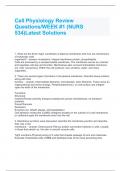
-
Cell Physiology Review Questions/WEEK #1 (NURS 534)Latest Solutions
- Exam (elaborations) • 4 pages • 2024
- Available in package deal
-
- $10.99
- + learn more
1. What are the three major constitutes of plasma membranes and how are membranes of eukaryotic cells organized? - answer--cholesterol, integral membrane protein, phospholipids. Cells are enclosed by a semipermeable membrane. The membrane serves as a barrier and regulates cell size and function. Membranes also surround intracellular structures (ex. mito, lysosomes). Within the cell (cytosol): ions, proteins, water, and many organelles. 2. There are several types of proteins in the plasma me...

-
Cell Physiology Certification Exam Questions and CORRECT Answers
- Exam (elaborations) • 9 pages • 2024
-
- $7.99
- + learn more
Cell Theory - Every living thing is made up of cells Basic Tenent of biology Prokaryotes - Cells with no nucleus lack internal cellular bodies called organelles do not divide by mitosis included= bacteria Eukaryotes - Have nucleus Have organelles divide by mitosis included= plants, animals, humans cell membrane - (also known as cell membrane) lies at the border of the cells primarily made up of proteins and lipids, especially phospholipids
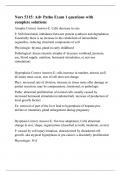
-
Nurs 5315: Adv Patho Exam 1 questions with complete solutions
- Exam (elaborations) • 83 pages • 2024
-
- $16.49
- + learn more
Atrophy Correct Answer-E. Cells decrease in size P. Still functional; imbalance between protein synthesis and degradation. Essentially there is an increase in the catabolism of intracellular organelles, reducing structural components of cell Physiologic: thymus gland in early childhood Pathological: disuse (muscle atrophy d/ decrease workload, pressure, use, blood supply, nutrition, hormonal stimulation, or nervous stimulation) Hyperplasia Correct Answer-E: cells increase in number, mitosi...
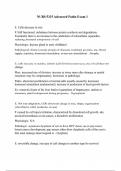
-
NURS 5315 Advanced Patho Exam 1
- Exam (elaborations) • 39 pages • 2024
-
Available in package deal
-
- $12.00
- + learn more
E. Cells decrease in size P. Still functional; imbalance between protein synthesis and degradation. Essentially there is an increase in the catabolism of intracellular organelles, reducing structural components of cell Physiologic: thymus gland in early childhood Pathological: disuse (muscle atrophy d/ decrease workload, pressure, use, blood supply, nutrition, hormonal stimulation, or nervous stimulation) - Atrophy E: cells increase in number, mitosis (cell division) must occur, size of c...
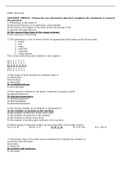
-
PHYS 261 Mid Term exam review Q&A
- Exam (elaborations) • 14 pages • 2023
-
- $14.99
- 1x sold
- + learn more
PHYS Mid Term MULTIPLE CHOICE. Choose the one alternative that best completes the statement or answers the question. 1) Physiology is the study of A) the facial features as an indication of personality. B) the tissues and organs of the body at the microscopic level. C) growth and reproduction. D) the normal functions of the organ systems. E) the structure of the body. 2) The following is a list of several levels of organization that make up the human body. 1. tissue 2. cell 3. orga...
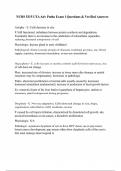
-
NURS 5315 UTA Adv Patho Exam 1 Questions & Verified Answers
- Exam (elaborations) • 67 pages • 2024
-
- $12.00
- + learn more
Atrophy - E. Cells decrease in size P. Still functional; imbalance between protein synthesis and degradation. Essentially there is an increase in the catabolism of intracellular organelles, reducing structural components of cell Physiologic: thymus gland in early childhood Pathological: disuse (muscle atrophy d/ decrease workload, pressure, use, blood supply, nutrition, hormonal stimulation, or nervous stimulation) Hyperplasia - E: cells increase in number, mitosis (cell division) must oc...
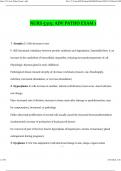
-
NURS 5315 Advanced Pathophysiology Exam 1 2024 Actual Questions with Verified Answers, 100% Guarantee Pass
- Exam (elaborations) • 96 pages • 2024
-
- $12.99
- + learn more
NURS 5315 Advanced Pathophysiology Exam 1 2024 Actual Questions with Verified Answers, 100% Guarantee Pass Atrophy: E. Cells decrease in size P. Still functional; imbalance between protein synthesis and degradation. Essentiallythere is an increase in the catabolism of intracellular organelles, reducing structuralcomponents of cell Physiologic: thymus gland in early childhood Pathological: disuse (muscle atrophy d/ decrease workload, pressure, use, bloodsupply, nutrition, hormonal stimulation, or...

-
Test Bank Cell Physiology: Chapter 4: Cells and Organelles A+ Graded Questions & 100% Answers, 2024
- Exam (elaborations) • 7 pages • 2024
-
Available in package deal
-
- $8.99
- + learn more
Which of the following is characteristic of eukaryotic cells? A) binary fission B) membrane-bounded nucleus C) peptidoglycan cell wall D) 70S ribosomes E) smaller than 5 µm in diameter - CORRECT ANSWER-membrane-bounded nucleus The methanobacteria, halobacteria, and sulfobacteria are included in which domain? A) bacteria B) protista C) blue-green algae D) archaea E) eukarya - CORRECT ANSWER-archaea Experiments by Stanley Miller in the 1950s demonstrated that the first organic mol...
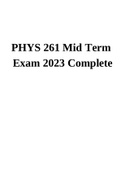
-
PHYS 261 Mid Term Exam 2023 Complete
- Exam (elaborations) • 15 pages • 2023
- Available in package deal
-
- $14.49
- 1x sold
- + learn more
PHYS 261 Mid Term Exam 2023 Complete. Physiology is the study of A) the facial features as an indication of personality. B) the tissues and organs of the body at the microscopic level. C) growth and reproduction. D) the normal functions of the organ systems. E) the structure of the body. 2) The following is a list of several levels of organization that make up the human body. 1. tissue 2. cell 3. organ 4. molecule 5. organism 6. organ system The correct order from the smallest to th...
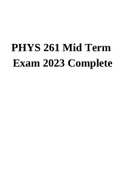
-
PHYS 261 Mid Term Exam 2023 Complete | Human Physiology
- Exam (elaborations) • 15 pages • 2023
-
Available in package deal
-
- $16.49
- 1x sold
- + learn more
PHYS 261 Mid Term Exam 2023 Complete | Human Physiology. How genetics influences the body’s response to drugs is called A) pharmacokinetics. B) pharmacogenomics. C) pharmacogenetics. D) pharmageddon. E) pharmacodynamics. 5) The atomic number of an element is equivalent to A) the number of protons in the nucleus. B) the number of electrons in the outer shell. C) the number of neutrons in the nucleus. D) the electrical charge of an atom. E) the number of protons plus neutrons in the n...

How did he do that? By selling his study resources on Stuvia. Try it yourself! Discover all about earning on Stuvia


